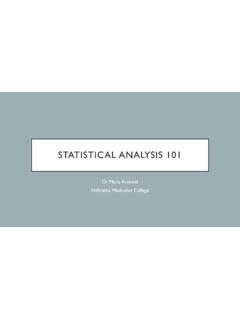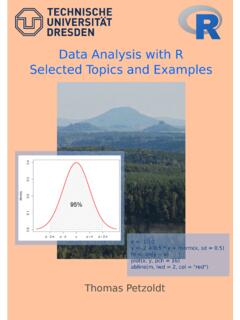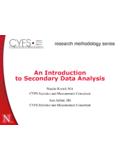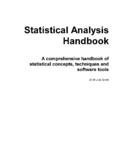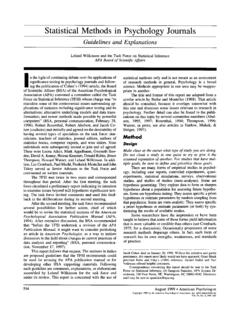Transcription of Statistical Methods for Research Workers - Haghish
1 BIOLOGICAL MONOGRAPHS AND MANUALS General Editors: F. A. E. CREW, Edinburgh D. WARD CUTLER, Rothamsted No. V Statistical Methods for Research Workers BIOLOGICAL MONOGRAPHS AND MANUALS THE PIGMENTARY EFFECTOR SYSTEM By L. T. Hogben, London School of Economics. THE ERYTHROCYTE AND THE ACTION OF SIMPLE HlEl\IOLYSINS By E. Ponder, New York University. ANIMAL GENETICS: AN INTRODUCTION TO THE SCIENCE OF ANIMAL BREEDING By F. A. E. Crew, Edinburgh University. REPRODUCTION IN THE RABBIT By J. Hammon~, School of Agriculture, Cambridge. Statistical Methods FOR RESI<:ARCH Workers - By R. A. Fisher, University of London.., THE COMPARATIVE ANATOMY, HISTOLOGY, AND DE~ELOPMENT OF THIe PITUITARY BODY By G. R. de Beer, Oxford University. THE COMPOSITION AND DISTRIBUTION OF THE PROTOZOAN FAUNA OF THE SOIL By H. Sandon, Egyptian University, Cairo. THE SPECIES PROBLEM By G. C. Robson, British Museum (Natural History). THE MIGRATION OF BUTTERFLIES By C. B. Williams, Rothamsted Experimental Station.
2 GROWTH AND THE DEVELOP:\IENT OF MUTTON QUALITIES IN THE SHEEP By John Hammond, Cambridge. MATERNAL BEHAVIOUR IN THE RAT By Bertold P. Wiesner and Norah M. Sheard. And other volumes are in course 0/ puJilication. Statistical Methods for Research Workers BY R. A. FISHER, , Formerly Fellow oj Conville and Caius Colle/;e, Cambridge Honorary Member, American Statistical Assoc~f!tl0! ~ .. Calton Professor, ziver~ YA'l0 LOI!,ffn I 1,.' I, j FIFTH EDITION-REVISED AND ENLARGED -ANGRAU Central Library Hydl'rabad G3681 1111 " OL~C~r;-.~OYD EDINBURGH: TWEEDDALE COURT LONDON: 33 PATERNOSTER ROW, I934 }IADE; IN OLIVER AND :R~AT BRITAIN BY OYD LTD ., EDINBURGH EDITORS' PREFACE THE increasing specialisation in biological inquiry has made it impossible for anyone author to deal adequately with current advances in knowledge. It has become a matter of considerable difficulty for a Research stud~nt to gain a correct idea of the present state of knowledge of a subject fn which he himself is interested.
3 To meet this situation the text-book is' being supplemented by the monograph. The aim of the present series is to provide authori-tative accounts of what has been done in some of the diverse branches of biological investigation, and at the same time to give to those who have contributed notably to the development of a particular field of inquiry an opportunity of presenting the results of their resear~ches, scattered throughout the scientific journals, in a more extended form, showing their relation to what has already been done and to problems that remain to be solved. The present generation is witnessing" a return to the practice of older days when animal physiology was not yet divorced from morphology." Con-spicuous progress is now being seen in the field of general physiology, of experimental biology, and in the application of biological principles to economic problems. Often the analysis of large masses of data by Statistical Methods is necessary, and the biological worker is continually encountering advanced v VI EDITORS' PREFACE Statistical problems the adequate solutions of which are not found in current Statistical text-books.
4 To meet these needs the present monograph was pre-pared, and the early call for the second and later editions indicates the success attained by the author In this project. F. A. E. C. D. W. C. PREFACE TO FIRST EDITION FOR several years the author has been working In somewhat intimate co-operation with a number of biological Research departments; the present book is in every sense the product of this circumstance. Daily contact with the Statistical problems which present themselves to the laboratory worker has stimulated the purely mathematical researches upon which are based the Methods here presented. Little experience is sufficient to show that the traditional machinery of Statistical processes is wholly unsuited to the needs of practical Research . Not only does it take a cannon to shoot a sparrow, but it misses the sparrow! The elaborate mechanism built on the theory of infinitely large samples is not accurate enough for simple labora-tory data . Only by systematically tackling small sample problems on their merits does it seem possible.
5 To apply accurate tests to practical data . Such at least has been the aim of this book. lowe more than I can say to Mr W. S. Gosset, Mr E. Somerfield, and Miss W. A. Mackenzie, who have read the proofs and made many valuable sugges-tions. Many small but none the less troublesome errors have been removed; I shall be grateful to readers who will notify me of any further errors and ambiguities they may detect. ROTHAMSTED EXPERIMENTAL STATION, February 1925. vii PREFACE TO FIFTH EDITION THE rapid demand for a fifth edition has more than justified the author's hope that use could be made of a book which, without entering into the mathe-matical theory of Statistical Methods , should embody the latest results of that theory, presenting them in the form of practical procedures appropriate to those types of data with which Research Workers are actually concerned. Those critics who would like to have seen the inclusion of mathematical proofs of the more important propositions of the underlying theory, must still be referred to the technical publications given in the list of sources.
6 There they will encounter exactly those difficulties which it would be undesirable to import into the present work; and will perceive that modern statistics could not have been developed without the elaboration of a system of ideas, logical and mathe-matical, which, however fascinating in themselves, cannot be regarded as a necessary part of the equip-ment of every Research worker . To present "elementary proofs," of the kind which do not involve these ideas, would be really to justify the censure of a second school of critics, who, rightly feeling that a fallacious proof is worse than none, are eager to decry any attempt to "teach people to run before they can walk." The actual scope of the present volume really exempts it from ix x PREFACE TO FIFTH EDITION this criticism, which, besides, in an age of technicai co-operation, has seldom much force. The practical application of general theorems is a different art from their establishment by mathematical proof, and one useful to many to whom the other is unnecessary.
7 In the second edition the importance of providing a striking and detailed illustration of the principles of Statistical estimation led to the addition of a ninth chapter. The subject had received only general discussion in the first edition, and, in spite of its practical importance, had not yet won sufficient attention from teachers to drive out of practice the demonstrably defective procedures which were stiII unfortunately taught to students. The new chapter superseded Section 6 and Example I of the first edition; in the third edition it was enlarged by two new sections (57' I and 57' 2) illustrating further the applicability of the method of maximum likelihood, and of the quantitative evaluation of information. In Section 27 a generalised form for the series of orthogonal polynomials was added to the third edition, in response to the need which is felt, with re~pect to some important classes of data , to use polynomials of higher degree than the fifth. Simple and direct algebraic proofs of the Methods of Sections 28 and 28 I have been published by Miss F.
8 E. Allan. In the fourth edition the Appendix to Chapter II I., on technical notation, was entirely rewritten, since the inconveniences of the moment notation seemed by that time definitely to outweigh the advantages r formerly conferred by its familiarity. The principal \ PREFACE TO FIFTH EDITION Xl new matter in that edition was added m response to the increasing use of the analysis of covariance, which is explained in Section 49' I. Since several writers have found difficulty in applying the appro-priate tests of significance to deviations from regression formulce, this section has been further enlarged in the fifth edi tion. Other new sections in this edition are 21'01, giving a correction for continuity recently introduced by F. Yates, and 21 02 giving the exact test of significance for 2 x 2 tables. Workers who are accustomed to handle regression equations with a large number of variates will be interested in Section 29' I, which provides the relatively simple adjustments to be made when, at a late stage, it is decided that one or more of the variates used may with advantage be omitted.
9 The possibility of doing this without laborious recalcu-lations should encourage Workers to make the list of independent variates included more comprehensive than has, in the past, been thought advisable. Section 5, formerly occupied by an account of the tables available for testing significance, has now been given to a historical note on the principal contributors to the development of Statistical reasoning. With respect to the folding copies of tables bound with the book, it may be mentioned that many laboratory Workers , who have occasion to use them constantly, have found it convenient to mount these on the faces of triangular or square prisms, which may be kept near at hand for immediate reference. The practical advantages of this plan have made ! , . ~ .. ' Xll PREFACE TO FIFTH EDITION it seem worth while to bring it to the notice of all readers. I t should be noted that numbers of sections, tables and examples have been unaltered by the insertion of fresh material, so that references to them, though not to pages, will be valid irrespective the edition used.
10 GALTON LABORATORY, October 1934. ,Po 1. II. II. lV. CONTENTS EDITORS' PREFACE PREFACE TO FIRST EDITION PREFACE TO FIFTH EDITION INTRODUCTORY DIAGRAMS DISTRIBUTIONS TESTS OF GOODNESS OF FIT, INDEPENDENCE AND HOMOGENEITY; WITH TABLE OF X2 V. TESTS OF SIGNIFICANCE OF fofEANS, DIFFERENCES OF MEANS, AND REGRESSION COEFFICIENTS VI. THE CORRELATION COEFFICIENT II. INTRACLASS CORRELATIONS AND THE analysis OF VARIANCE. PAGE v vii IX 25 41 80 112 160 I!. FURTHER ApPLICATIONS OF THE analysis OF VARIANCE 236 :X. THE PRINCIPLES OF Statistical ESTIMATION 273 SOURCES USED FOR data AND Methods BIBLIOGRAPHY INDEX TABLES I. AND II. NORMAL DISTRIBUTION II. TABLE OF X2 lV. TAELE OF t .4 .A. CORRELATION COEFFICIENT-SIGNIFICANT VALUES '.E. CORRELATION COEFFICIENT-TRANSFORMED VALUES vI. TAELE OF Z xiii 307 311 317 Statistical Methods for Research Workers Statistical Methods FOR Research Workers I INTRODUCTORY 1. The Scope of Statistics If HE science of statistics is essentially a branch of Applied Mathematics, and rna y be regarded as mathematics applied to observational data .



